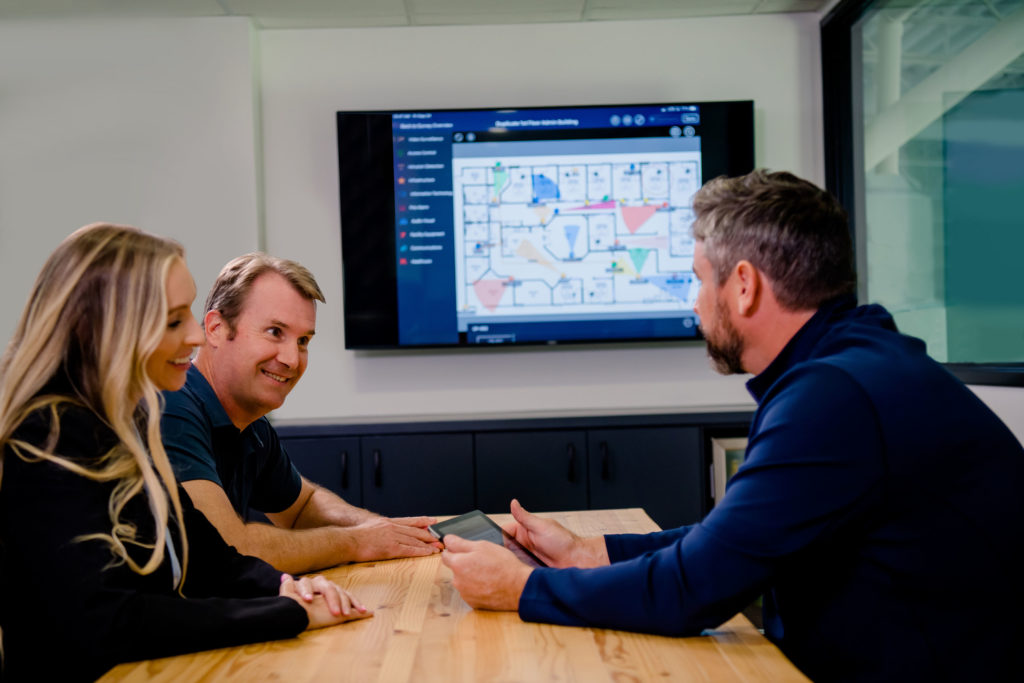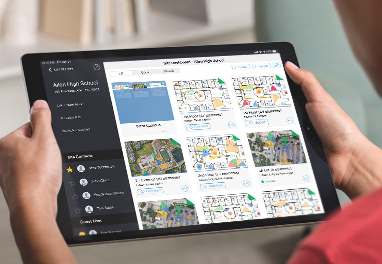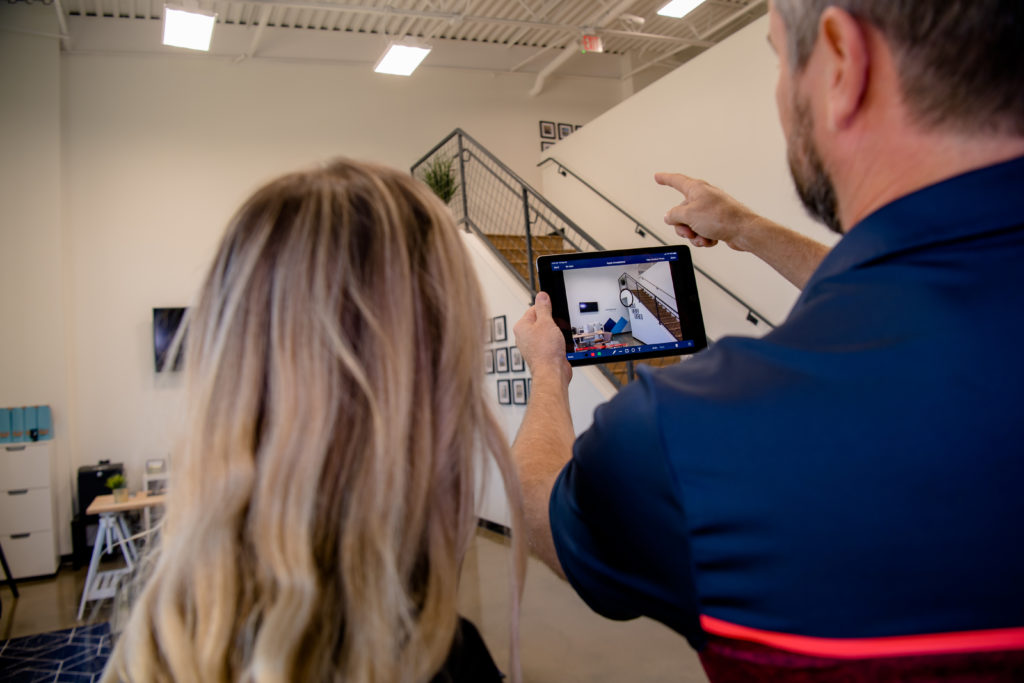With fuel prices at all-time highs and ongoing labor shortages throughout the physical security industry, it’s more important than ever to deliver superior service while keeping truck rolls to an absolute minimum. One of the greatest opportunities is in the exploration period — the physical site survey and any follow-up visits prior to execution and installation.
With many potential errors, this process is notoriously imprecise, which can lead to hours of follow-up work and additional costly site visits. Below we identify 5 types of errors that lead to slowdowns and our recommended system survey design solutionsfor each.
1. Failing to Prepare Ahead of Time with a Digital Floor Plan
The first and most common mistake we see is a failure to adequately prepare for the site survey by obtaining a digital floor plan and setting the scale for the meeting. Often times, a sales rep or project manager goes out with a yellow pad of paper, a paper map and a cell phone. Capturing the customer requirements this way leads to a number of challenges and a costly domino impact later.
This poor judgment leaves system integrators with nothing to base their estimates or proposals on other than their memory, a few smartphone photos, and whatever handwritten notes they jotted down. And customers can’t visualize what you’re proposing during the site survey nearly as well. Without a mobile, digital survey instrument, camera angles and blind spots are guesses at best rather than a proper calculation and visualization.,
Failure to set the scale of a floor plan is a related problem: without a proper plan and data , you won’t be able to show an accurate area of coverage or set appropriate boundaries for intrusion detection.
Solution: Come prepared with a digital floor plan in System Surveyor

The solution here is straightforward: do the site survey research and work beforehand, so you can come prepared with a digital floor plan already loaded into a collaborative system design tool like System Surveyor.
A digital floor plan gives you a place to take notes as you walk a site, and it gives you and the customer a visual reference point as you discuss potential physical security system installations. Identify more precisely where a camera should go, where a Wireless Access Point is needed, or where a sensor will do the most good. You’ll have better, more accurate data when you leave, and your customer will have an infinitely deeper understanding and ownership of what exactly you’re proposing. There’s nothing worse than figuring out 75% of the way through the project that you had different ideas in mind.
With a digital floor plan , you can quickly and easily set the scale for the entire building or property— something that’s nearly impossible to do accurately on paper. With a measurement of a door entry or some other internal element, System Surveyor can automatically populate dimensions for the entire diagram for an interior floor plan. For exterior projects, use the Google Maps integration and location-based services to get a great satellite image with automatic scale – perfect for parking lots or other use cases. With a proper scale, even your initial work during the site survey can accurately map out Wi-Fi access points, area of coverage for security cameras, proper locations for motion detectors, and more. Reduce your site survey measurement errors with accurate, distance-oriented calculations early in the process.
Bonus tip: We know getting a digital floor plan isn’t always as simple as it sounds. Sometimes an official floor plan simply can’t be found — perhaps the building is old or the only paper copies have been lost or destroyed. Even still there are ways to overcome this if you get creative. If you’re struggling to obtain these for client sites, we’ve published another post that could help you: check out 5 Helpful Tips to Get a Customer’s Floor Plan.
2. Setting Poor Expectations with Prospects About the Digital Site Survey Process
The mistake to avoid is setting the wrong expectations with your prospects and customers about the digital site survey process—or failing to set any expectations at all.
Consider this: if digital site surveys are still relatively new for your business, your customers have almost certainly never experienced one. Your clients and prospects have endured traditional site surveys before, but they’re guessing or making assumptions about what, if anything, will be different this time.
Often customers will expect the process to be faster than is realistic, which can lead to them rushing you through the facility. They also might not be prepared to answer questions you have—because they didn’t know you’d be asking. This is a game changer to address this problem and to be consistent.
Solution: Communicate to set expectations

Assume your prospects are envisioning your digital site survey like it’s any old site survey and communicate with them about any differences between the two.
You don’t want to arrive on site and hear, “This is a 30-minute meeting, right?”
People won’t know what to give you unless you tell them, and you can’t produce the excellent results you’re capable of if you don’t get what you need.
Let your prospect know that you’re conducting an in-person digital site survey and that it might take a little longer than they’re used to, but the results will be worth the time, and they’ll get the best, most accurate proposal that they’ve ever witnessed. They’ll even have a visual map of the site survey when you’re finished. And don’t be afraid to lean into the fact that you’re different: 73% are still doing it the old way, so this is a great way to differentiate yourself. You’ve just elevated your professionalism in ways that build trust and confidence, which translates to closing a higher value project and the start of a better long-term relationship.
Pro Tip: Use or modify this script to help you set better expectations with prospects and clients.
I want to let you know that when I come out for the site survey, I’ll be conducting it digitally. Our digital site surveys run a little differently than what you’re used to. There won’t be any old-school paper floorplan, and I won’t be jotting notes down on a yellow pad. Instead, I’ll have a digital floorplan on my tablet. It’s already loaded and set to scale, so we’ll be able to produce much more accurate results. You’ll also get to visualize your solution along with me and give input as we go. This survey might take a little longer up front than an old-school one, but you’ll have a visual map of our work when we’re done. And we’ll typically have an accurate, decision-ready proposal available for you faster with your specific input.”
3. Going Back to Using Outdated Manual Methods
The next mistake we’re highlighting is sticking with or returning to outdated manual methods, like a yellow pad of paper, a paper floor plan, and cell phone photos of site elements. Yes, this is the way site surveys have been done for the last 20 years or so. However, it is not scalable and misses out not only on the customer experience improvement but also some serious efficiency improvements such as automating a bill of materials.
In the modern era, these outdated methods, well, look and feel outdated. Your client watches you fumble with them yet doesn’t receive any visual validation during the site survey. And once you get back to the office, there’s tons of inefficient work to make sense of your notes and turn them into something useful. This is not simply a mistake, but it can be a serious competitive disadvantage.
Solution: Use site survey collaboration software

The solution here is upgrading to a modern solution, such as System Surveyor’s site survey collaboration software. You’ll have a more elegant, more accurate place from which to conduct your site survey. Your client can offer instant feedback and even collaborate as you walk. And you’ll both have accurate, readable notes that are ready the moment you end the site survey.
As you drag and drop of the icons your customer will need, confirm the product in the field (when you can), you will be 80% completed before you’ve even returned to the office. Imagine no longer needing hours back at the office to do the next step.
4. Not Gathering Discovery Information Vital for Accurate First-Time Estimates
In an era of labor shortages and sky-high fuel prices, lowering the number of “truck rolls”, those times that you send out an installation or technician into the field for work, is a near imperative for your business. With that in mind, rolling out to a site without gathering the necessary discovery information is our next tactical error to avoid that has serious implications.
When system integrators fail to gather the necessary discovery information prior to arrival for a site survey (such as that all-important digital floor plan and pictures), the survey itself doesn’t provide the results that it could.
Along the same lines, once you’ve arrived for the site survey, be sure you’ve collected every bit of discovery information you’ll need to produce accurate estimates. Coming back a second (or third) time to round out some details you missed costs your business valuable hours and precious gallons of fuel.
To get a handle on the cost of a “truck roll”, consider this math for the typical U.S. based integrator depending on their market location and the impact to project margins:
- Assume 15 miles to a customer, 1 hour on site
- Drive time 30 minutes each way, plus the hour on site at loaded labor rate of $100/hour = $200
- Fuel: 15 miles x 2 = 30 miles at $4.99/gallon* = $10
- That’s $210 for an unnecessary or unproductive truck roll
These are not even the full opportunity cost of any of these “mistakes” or lack of preparation.
Solution: Invest the time upfront

Transitioning to a digital site survey process is a change — for you and for your customer. You’ll need to invest a little more time upfront but doing so will save you so much time throughout the rest of the process — and it stands a good chance of increasing your closure rate, too.
Make sure you ask the right questions and know what information you need before you arrive — with proper data collection, you won’t have to think through this on your feet while interacting with the customer. Also, be sure to take photos digitally so they can be associated with the proposed devices and systems which are “worth a thousand words” if they get into the right hands of the estimators, project managers and installers. For a picture is only valuable if accessed at the right time. n. This way you won’t have to correlate them later, and if you have a centralized estimator back at the office, that person may notice things that weren’t obvious during the site walk.
5. Leaving the Site Survey Without Getting Verbal Confirmation on Initial Design
The last unintended, but common mistake to highlight has to do with sealing the deal. Your digital site survey results give you the power to create a well-built initial design before you ever leave the site. This just isn’t possible under the old system, so some integrators don’t realize the missed opportunity even after they switch to digital. They may show the client a visually strong initial design, but they fail to ask for confirmation or buy-in and drive away unsure of the sale.
Solution: Obtain verbal agreement using a visual detailed initial design

When System Surveyor users maximize the app’s collaborative design ability, they often work with customers using drag and drop on a digital floor plan, giving their customers an exponentially clearer picture of what’s going into an estimate. This new level of clarity creates a new opportunity: getting verbal confirmation or a handshake agreement on the initial design.
Now you have the power to understand and overcome client concerns — on the first visit. And once you’ve done so, it only makes sense to push for a tentative agreement.
We believe in most cases you should be 90% sure you have the business before you end the digital site survey meeting. That’s the power System Surveyor can deliver.
Pro Tip: Use or modify this script to help you set better expectations with prospects and clients.
Thank you for taking extra time on the site survey. I hope that it was helpful and that it built confidence that you know our solution will directly fit your needs. Based on what we put together, when I send you the official design and proposal, is this confirmed and will you plan to sign off? Or, is there anything else we likely need to adjust?”
Most of these mistakes are not intended but are because there has been a “same old way we do business”. But consumers everywhere are getting more and more opportunity to “build their plans”. If you buy a couch from Crate & Barrel, you can visualize a sectional and see what it would look like in your room. Customer expectations for visualizing solutions have gone up and now is the time to help them embrace the project at a new level.
There is no lack of business, only an opportunity to capitalize on it more efficiently than ever. Now is a great time to dive into digital site surveys and site assessments with the best software in the business. Reach out today for a demo of System Surveyor.
